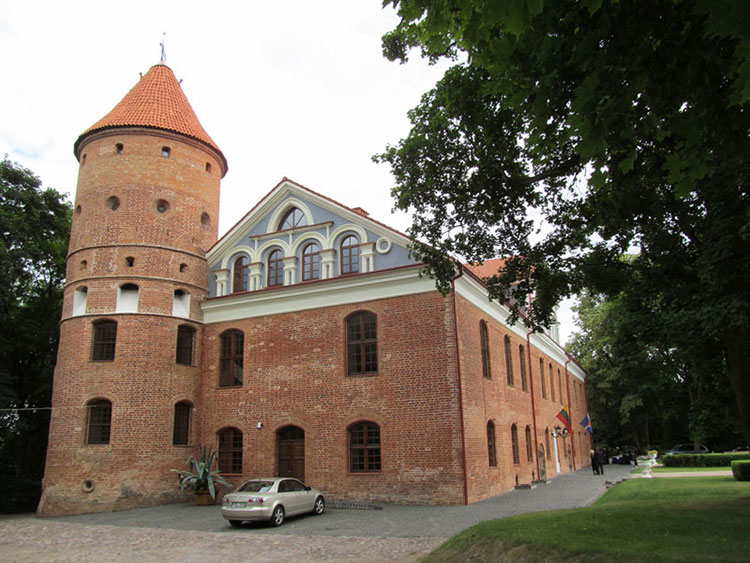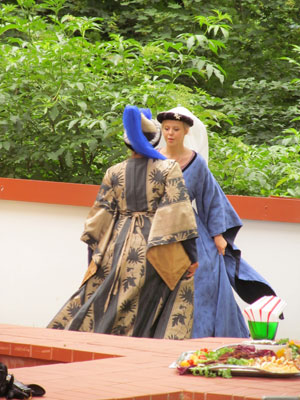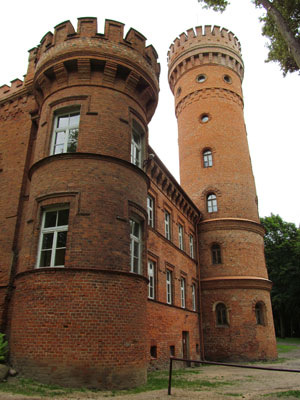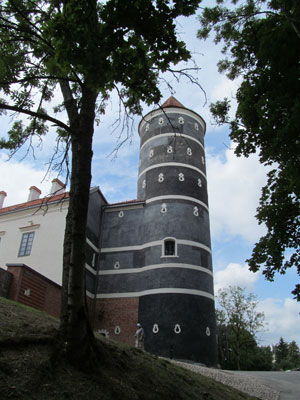Lithuanian castles along the Nemunas
This item appears on page 61 of the December 2013 issue.
The Nemunas River, the longest river in Lithuania, wends its way from the Lithuania/Belarus border north toward Kaunas, then westward across southern Lithuania to empty into the Curonian Lagoon.
In the Middle Ages, the Nemunas (or Neman) was the demarcation line between the Teutonic Knights to the south and the Lithuanians to the north, whom the Knights, a military crusading order, sought to conquer. It was a territorial struggle that occupied much of the 13th, 14th and early 15th centuries. It was also an attempt by the Christian knights to forcibly convert the still pagan Lithuanians.
The Teutonic Knights built earth-and-timber fortresses along the Nemunas. In 1410, after the Battle of Grunwald, which the Lithuanians call the Battle of Žalgiris, where the Knights were finally defeated, many of these former Teutonic strongholds became the sites of stone castles built either by Lithuanian grand dukes or by the nobility.
By the time these castles were built, it was the 16th and 17th centuries and the castles no longer needed defense structures such as sturdy towers with arrow slits or surrounding moats. Many nonetheless still included these features into the, then, prevalent Renaissance style. In effect, Renaissance-style manor houses were built with medieval features that were decorative rather than defensive.
On our 10th trip to Lithuania, in June-July 2013, my husband, Paul, and I visited three of these castles along a beautiful stretch of the Nemunas west of Kaunas, Lithuania’s second-largest city.
Raudondvaris
The first castle we visited was Raudondvaris, just seven miles west of Kaunas. The town of Raudondvaris is first mentioned in a Teutonic chronicle of the late 14th century. Here the Knights built a small fortress housing several hundred soldiers.
After Grunwald, however, Raudondvaris became the property of the Lithuanian Grand Dukes, who built a castle. Grand Duke Sigismund II Augustus (Žygimantas Augustas to the Lithuanians) gave this castle in 1549 to his wife, Barbara Radvilaitė, a member of the powerful Radvila/Radziwill family. It fell into disrepair after her death in 1551.
A new Renaissance-style red-brick palace was built around 1615, becoming the home of a number of noble families, including the wealthy Tiskevicˇius dynasty, which owned it for almost 100 years, from 1820 until World War I. Following extensive damage in World War II, the palace has been restored.
Today, visitors enter a park enclosing buildings from various eras of the castle’s history that once were estate offices, servants’ quarters and stables. Prominent among them is the red-brick manor house dominated by a single cylindrical tower that may date from the original castle.
The manor house now houses several small museums. We were not able to visit because the castle and its surrounding park is now a venue for concerts, festivals and private functions.
On the balmy Saturday summer afternoon we visited, there was a large christening party spread out on the lawn next to the manor house and a wedding party with a Renaissance theme going on inside. Some of the wedding party spilled outside to watch ladies garbed in 16th-century costume dance a stately pavane and to be served champagne by waiters dressed in heralds’ costumes.
The ghosts of past inhabitants would probably be happy to know that Raudondvaris has been given new life.
Raudonė
Raudonė, too, 32 miles farther west along a beautiful green stretch of the Nemunas, began its life as an earth-and-timber Teutonic fortress early in the 14th century. After that, its history is checkered.
It became the property of the Lithuanian Grand Dukes after the Battle of Grunwald. In the early 16th century, Sigismund II Augustus gave it to one of his knights, whose son built a manor house. A Polish family, the Oledskis, acquired it in the 18th century, followed in the early 19th century by a Russian prince, Platon Zubov, reputedly one of Catherine the Great’s lovers. His granddaughter was one of the last private owners of Raudonė.
Raudonė looks much like Raudondvaris, a large, solid, red-brick manor house incorporating a 110-foot-tall cylindrical Renaissance tower that can be climbed for a panoramic view over the estate.
Raudonė is now a school and, except when there is an exhibition, cannot be visited inside. But the park around the castle was busy when we visited. There were two bridal parties posing for photos. Also, two local entrepreneurs had set up shop, one offering horse rides, the other (dressed in a medieval outfit) offering archery.
The park around the castle is full of fir and pine trees. There is an ancient oak tree that is pointed out to visitors as being not only one of the oldest in Europe but the one that Grand Duke Gediminas (who founded Vilnius) lay under after he was mortally wounded following a siege of this castle in 1341.
Panemunė
Panemunė Castle, 6½ miles west of Raudonė, stands on a hill surrounded by woodlands and five small lakes. As with the first two castles, the site was first occupied by a Teutonic Knights hill fort built around 1340. In 1597 the land was sold to a Hungarian nobleman, Janusz Eperjesh. The castle overlooking the Nemunas that he began building was completed by one of his sons.
This castle remained in the family for 158 years, then passed briefly to a Swedish baron until purchased in 1759 by Antanas Gelgaudas, who turned it into a luxurious family manor house.
The Russians annexed Lithuania in 1795 after the dissolution of the Polish-Lithuanian Commonwealth. Two Gelgaudas brothers who had participated in the anti-Russian uprising of 1831 lost the family property when the Russians confiscated it.
As an aside, the great English actor Sir John Gielgud, who died in 2000, is a descendant of the Gelgaudas family.
Also, part of the Panemunė estate was once owned by a Lithuanian-American priest, Antanas Petraitis (1861-1933), who founded a monastery there.
Much of Panemunė has been restored. Stone buildings enclose a trapezoidal courtyard with two of the original four towers still standing at the corners of the restored west wing. One of the towers can be climbed while peering through gun ports on the way up. There’s a small museum in the west wing exhibiting 350-year-old tiles found during reconstruction, and there are residential quarters in the south wing awaiting restoration.
Better than Raudondvaris and Raudonė, Panemunė gives visitors a good idea of the castle’s evolution from Renaissance to Baroque to neoclassical.
The Gelgaudas family also created a classical-style park that has long since disappeared, although visitors still can stroll around the remaining five lakes surrounding the castle.
If you go…
We made this Nemunas castle excursion by driving a car from Vilnius, the capital of Lithuania. It took about 90 minutes to go the 70 miles, approximately, from Vilnius to Raudondvaris, the first castle we visited, skirting the city of Kaunas. The roads were excellent except for a short section outside Kaunas with road construction and detours.
In Vilnius we stayed for 16 nights at the superb Stikliai Palace Residence*, located on a cobblestone street in Old Town, one of the largest and most picturesque Old Towns in Eastern Europe. It is adjacent to and shares facilities with the Stikliai Hotel (Gaono str. 7, 01131 Vilnius, Lithuania; phone +370 5 264 9595, fax 5 212 3870).
On our last two trips to Lithuania we've stayed in the apartments, where rates for one- and two-bedroom apartments with all facilities range from €882 to €1,295 ($1,170-$1,717) per week (minimum, one week). In years past we stayed in the hotel, where rates for elegant double rooms now range from €160 to €550 (near $212-$729) per night.
The apartments are among the most comfortable we’ve ever stayed in, with upscale furnishings, washer/dryers, dishwashers, air-conditioning and views of the flower-filled inner courtyard or of Old Town church steeples.
There’s also the plus of having two wonderful restaurants on the premises. I've eaten at both many times, especially the Stikliai Alude (contact hotel), where we dined six times in our 16 nights; it's that good. The Alude serves authentic Lithuanian food, and the cost for dinner for two, with drinks (usually Lithuanian beer, like Kalnapilis), ran a reasonable $30 to $40. I still salivate about their potato pancakes and cold beet soup.
The haute cuisine French restaurant Stikliai (phone +370 5 264 9580, fax 5 212 3870 or email restaurant@stikliaihotel.lt), though very expensive, is the sort of place that you never forget for both its food and ambiance. Depending on the type of wine and what's ordered, dinner for two, with a glass of wine each, could cost upward of $100.
A beginning room rate of $212 at the hotel is not unreasonable for what you get, and the apartments are a steal. It's the quality of the place that gets me on every visit. I'd go to Vilnius just to stay at the Stikliai Palace Residence.




